



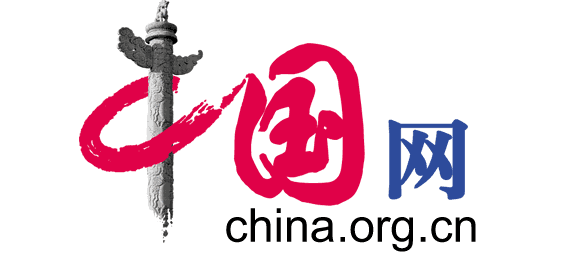

 1This photo, taken on October 1, 1949, during a ceremony held at Tian'anmen Square in capital city Beijing, shows Chinese former Chairman Mao Zedong declaring that the People's Republic of China was formally established.
1This photo, taken on October 1, 1949, during a ceremony held at Tian'anmen Square in capital city Beijing, shows Chinese former Chairman Mao Zedong declaring that the People's Republic of China was formally established.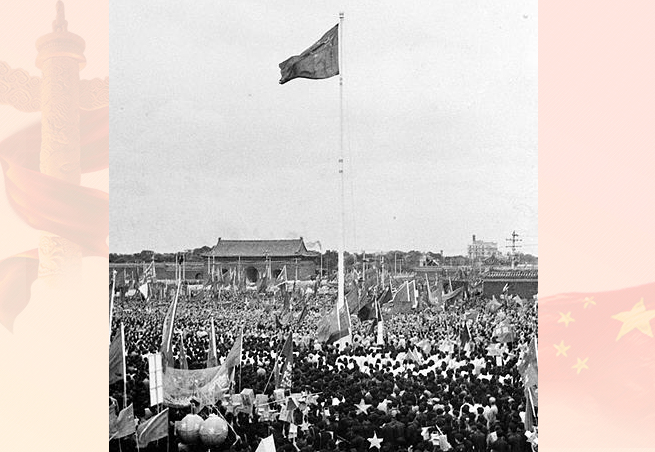 2The national flag of the People's Republic of China was raised in Tiananmen Square on October 1, 1949, the day the People's Republic of China was formally established.
2The national flag of the People's Republic of China was raised in Tiananmen Square on October 1, 1949, the day the People's Republic of China was formally established.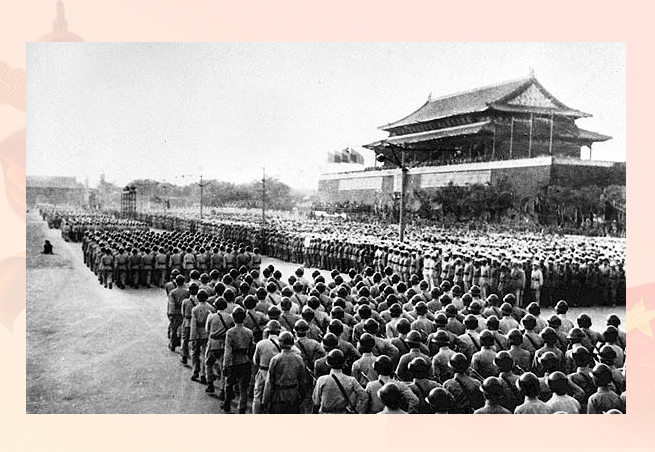 3The land force of the Chinese People's Liberation Army (PLA) passes through Tiananmen Square during the nation founding day parade on October 1, 1949.
3The land force of the Chinese People's Liberation Army (PLA) passes through Tiananmen Square during the nation founding day parade on October 1, 1949. 4The air force of the PLA performs during the nation founding day parade on October 1, 1949, in Beijing. A total of 17 jets attended the ceremony.
4The air force of the PLA performs during the nation founding day parade on October 1, 1949, in Beijing. A total of 17 jets attended the ceremony.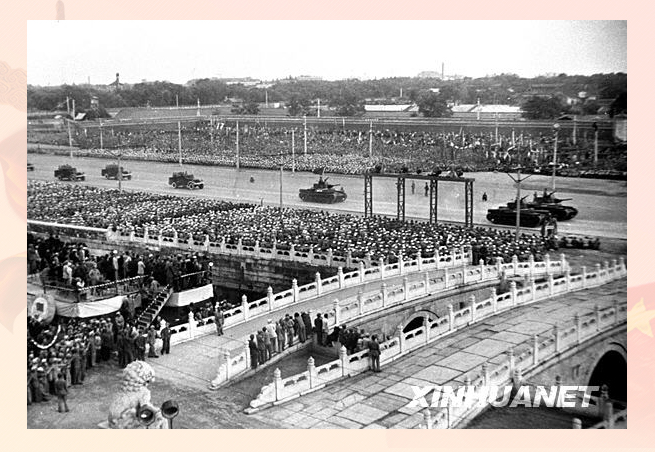 5The armored unit of the PLA passes Tiananmen Square during the nation founding day parade on October 1, 1949.
5The armored unit of the PLA passes Tiananmen Square during the nation founding day parade on October 1, 1949. 6The newly founded navy force of the PLA parades in Tiananmen Square on October 1, 1949.
6The newly founded navy force of the PLA parades in Tiananmen Square on October 1, 1949. 7Zhu De, China's former top military commander, examines a parade of PLA troops on October 1, 1949.
7Zhu De, China's former top military commander, examines a parade of PLA troops on October 1, 1949. 8Celebrating the 1st anniversary of the People's Republic of China, troops march through Tiananmen Square in the National Day Parade, October 1, 1950.
8Celebrating the 1st anniversary of the People's Republic of China, troops march through Tiananmen Square in the National Day Parade, October 1, 1950.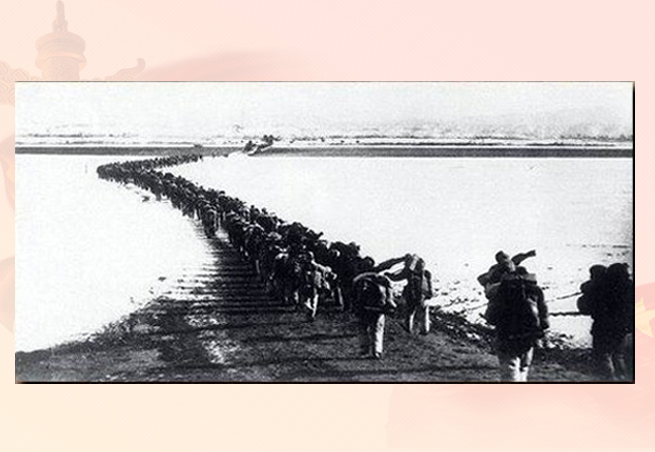 9This photo, taken on October 19, 1950, shows the Chinese People's Volunteer Army crossing Yalu River on foot to enter Korea, marking the start of China's War to Resist American Aggression and Aid Korea initiative during the Korean War.
9This photo, taken on October 19, 1950, shows the Chinese People's Volunteer Army crossing Yalu River on foot to enter Korea, marking the start of China's War to Resist American Aggression and Aid Korea initiative during the Korean War.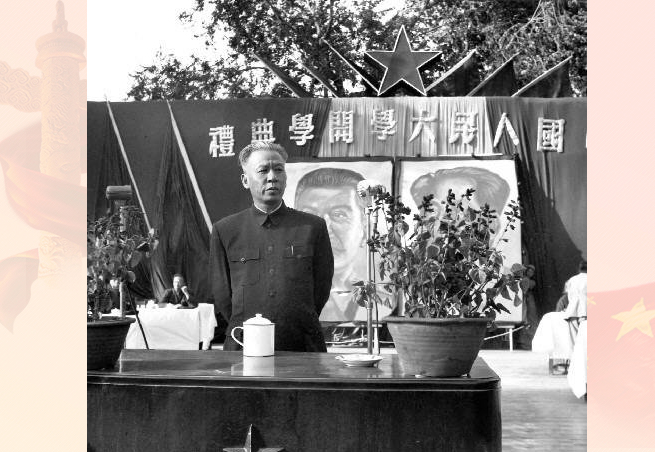 10Liu Shaoqi, vice chairman of the Central People's Government committee (October 1949-September 1954), announces on October 3, 1950, that Renmin University of China has been formally established. Renmin University was the first new model university of the People's Republic of China.
10Liu Shaoqi, vice chairman of the Central People's Government committee (October 1949-September 1954), announces on October 3, 1950, that Renmin University of China has been formally established. Renmin University was the first new model university of the People's Republic of China. 11Gao Caiguan and his family members from Jiaxing city in southeast China's Zhejiang Province receive their land certificate as a benefit from the Land Reform Movement. Starting from the winter of 1950, the Land Reform Movement (1950-1953) abolished the feudal landlord land ownership and established peasant land ownership.
11Gao Caiguan and his family members from Jiaxing city in southeast China's Zhejiang Province receive their land certificate as a benefit from the Land Reform Movement. Starting from the winter of 1950, the Land Reform Movement (1950-1953) abolished the feudal landlord land ownership and established peasant land ownership. 12Mao Zedong converses with Ngapoi Ngawang Jigme, a delegate of the local Tibetan government's negotiating team. During late April 1951, members of the team traveled to Beijing to negotiate the peaceful liberation of Tibet, resulting in the central people's government and local government of Tibet signing a "Seventeen Point Agreement for the Peaceful Liberation of Tibet".
12Mao Zedong converses with Ngapoi Ngawang Jigme, a delegate of the local Tibetan government's negotiating team. During late April 1951, members of the team traveled to Beijing to negotiate the peaceful liberation of Tibet, resulting in the central people's government and local government of Tibet signing a "Seventeen Point Agreement for the Peaceful Liberation of Tibet". 13The delegate of the local Tibetan government's negotiating team, Ngapoi Ngawang Jigme, presents a hada to Chairman Mao Zedong on May 24, 1951. Presenting a hada, a long piece of silk, is a common Tibetan custom to express best wishes on many occasions.
13The delegate of the local Tibetan government's negotiating team, Ngapoi Ngawang Jigme, presents a hada to Chairman Mao Zedong on May 24, 1951. Presenting a hada, a long piece of silk, is a common Tibetan custom to express best wishes on many occasions.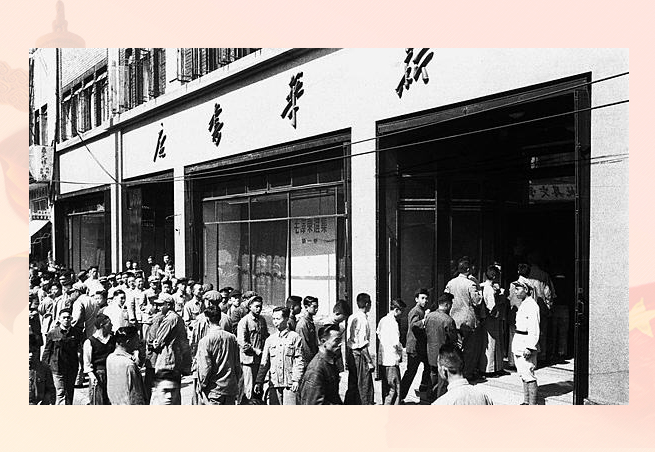 14Crowds form a queue to buy the newly published book, Selected Works of Mao Zedong, at Shanghai Xinhua Bookstore on October 12, 1951. In order to help people learn Mao Zedong's way of thinking and better understand the history of China's revolution, the central government ordered Beijing's People's Publishing House to publish the first volume of Selected Works of Mao Zedong nationwide.
14Crowds form a queue to buy the newly published book, Selected Works of Mao Zedong, at Shanghai Xinhua Bookstore on October 12, 1951. In order to help people learn Mao Zedong's way of thinking and better understand the history of China's revolution, the central government ordered Beijing's People's Publishing House to publish the first volume of Selected Works of Mao Zedong nationwide.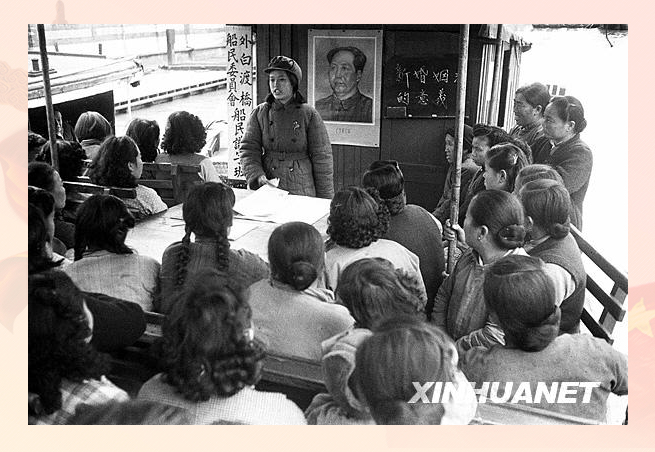 15This photo, taken on November 17, 1951, shows staff from the Shuishang branch of Shanghai police security promoting and explaining "Marriage Law of the People's Republic of China". The law, carried out on May 1, 1950, was the first basic legal procedure of the People's Republic of China.
15This photo, taken on November 17, 1951, shows staff from the Shuishang branch of Shanghai police security promoting and explaining "Marriage Law of the People's Republic of China". The law, carried out on May 1, 1950, was the first basic legal procedure of the People's Republic of China.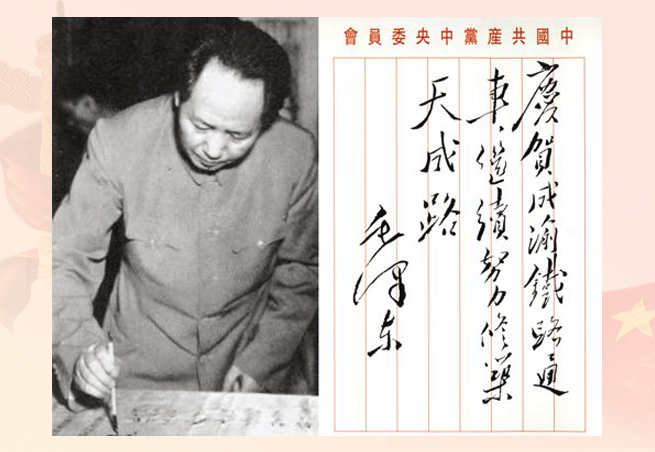 16This photo showcases Mao Zedong's inscription, "Congratulations on the Chengdu-Chongqing railway opening to the public; continue your efforts to build the Tianshui-Chengdu railway" (Tianshui is located in the northwest China's Gansu Province). The Chengdu-Chongqing railway was the first railway completely designed by Chinese people and was built using home-made materials.
16This photo showcases Mao Zedong's inscription, "Congratulations on the Chengdu-Chongqing railway opening to the public; continue your efforts to build the Tianshui-Chengdu railway" (Tianshui is located in the northwest China's Gansu Province). The Chengdu-Chongqing railway was the first railway completely designed by Chinese people and was built using home-made materials. 17This photo shows the first train of the Chengdu-Chongqing line departing from Chengdu railway station. The Chengdu-Chongqing railway, which opened to the public on July 1, 1952, was the first railway of the People's Republic of China.
17This photo shows the first train of the Chengdu-Chongqing line departing from Chengdu railway station. The Chengdu-Chongqing railway, which opened to the public on July 1, 1952, was the first railway of the People's Republic of China.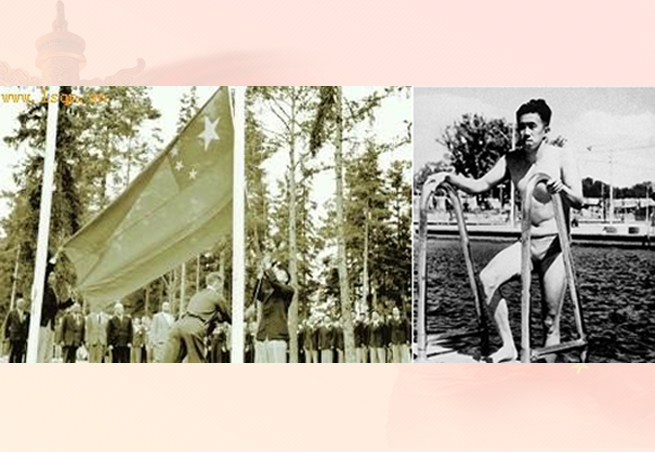 18In this photo, the left side shows the People's Republic of China's Olympic delegation raising the Chinese national flag in the Olympic Village on July 29, 1952; the right side shows Chinese swimmer Wu Chuanyu, one of Chinese athletes that participated in the 15th Helsinki Olympic Games in Finland. China was invited by the International Olympic Committee on July 17, 1952, but did not receive a formal invitation until just hours before the Olympic opening ceremony was to begin. After much effort, China finally arrived in Helsinki 10 days later and took part in the Olympic Games.
18In this photo, the left side shows the People's Republic of China's Olympic delegation raising the Chinese national flag in the Olympic Village on July 29, 1952; the right side shows Chinese swimmer Wu Chuanyu, one of Chinese athletes that participated in the 15th Helsinki Olympic Games in Finland. China was invited by the International Olympic Committee on July 17, 1952, but did not receive a formal invitation until just hours before the Olympic opening ceremony was to begin. After much effort, China finally arrived in Helsinki 10 days later and took part in the Olympic Games. 19Chen Yun (left), one of the CPC Political Bureau members, is greeted by his Soviet hosts at Moscow airport on August 17, 1952. The visiting Chinese delegation arriving in the Soviet Union was headed by former Premier Zhou Enlai.
19Chen Yun (left), one of the CPC Political Bureau members, is greeted by his Soviet hosts at Moscow airport on August 17, 1952. The visiting Chinese delegation arriving in the Soviet Union was headed by former Premier Zhou Enlai.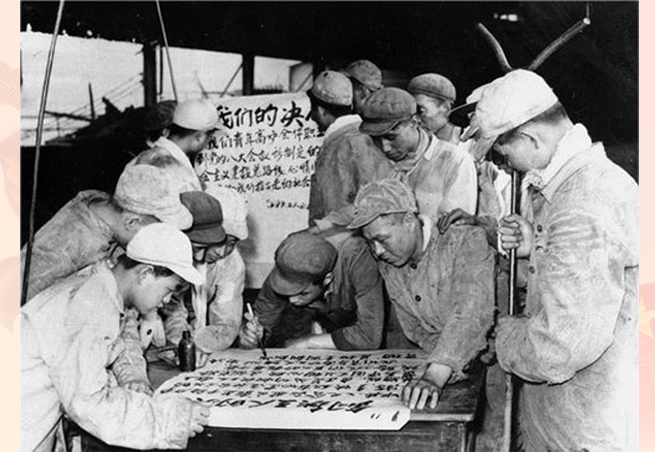 20In this photo, workers are responding enthusiastically to the nation's first "Five-year plan" that started on January 1, 1953. The "Five-year Plan", an important part of China's designs for its national economy, aimed to set up developing goals or draw up significant plans, such as national construction projects and productivity distribution programs.
20In this photo, workers are responding enthusiastically to the nation's first "Five-year plan" that started on January 1, 1953. The "Five-year Plan", an important part of China's designs for its national economy, aimed to set up developing goals or draw up significant plans, such as national construction projects and productivity distribution programs. 21Liu Zhengwu (1st from the right), one of the national model citizens of 1953, explains the theory of the "mill furnace cinder" to workers.
21Liu Zhengwu (1st from the right), one of the national model citizens of 1953, explains the theory of the "mill furnace cinder" to workers. 22Workers of Anshan Iron and Steel Company's Seamless Steel Tube Plant cheer for the nation's first home-made seamless steel tube in 1953.
22Workers of Anshan Iron and Steel Company's Seamless Steel Tube Plant cheer for the nation's first home-made seamless steel tube in 1953. 23The Korean delegation (right) and US delegation (left) sign the agreement in 1953. The Korean Armistice Talk, which lasted two years, reached an agreement on July 26, 1953.
23The Korean delegation (right) and US delegation (left) sign the agreement in 1953. The Korean Armistice Talk, which lasted two years, reached an agreement on July 26, 1953.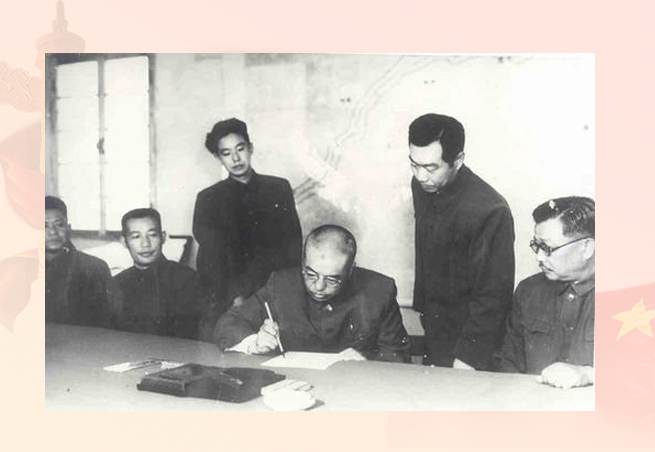 24Peng Dehuai, the general commander of the War to Resist American Aggression and Aid Korea, officially signs the Korean Armistice agreement on July 28, 1953. The Korean Armistice Talk, which lasted two years, reached an agreement on July 26, 1953.
24Peng Dehuai, the general commander of the War to Resist American Aggression and Aid Korea, officially signs the Korean Armistice agreement on July 28, 1953. The Korean Armistice Talk, which lasted two years, reached an agreement on July 26, 1953.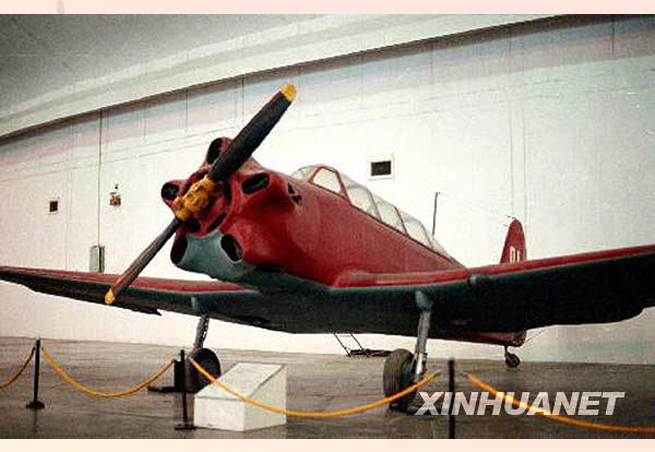 25This photo shows China's first home-made aircraft, the Type 5 Primary Trainer. Successful test flights of Type 5 Primary Trainer in July 1954 marked China as having the ability to produce aircraft.
25This photo shows China's first home-made aircraft, the Type 5 Primary Trainer. Successful test flights of Type 5 Primary Trainer in July 1954 marked China as having the ability to produce aircraft.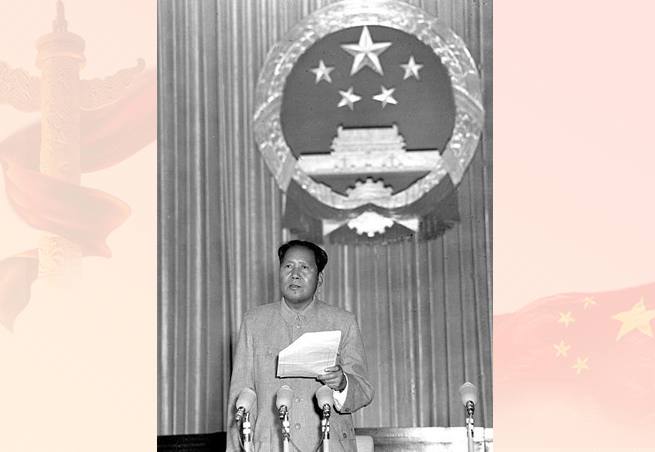 26The first session of the 1st National People's Congress opened in Huairen Hall, Zhongnanhai, in Beijing at 3 pm on September 15, 1954. In former Chairman Mao Zedong's opening speech, the main purposes of the congress were: framing the National Constitution, enacting some basic laws, delivering the government work report, and electing new leadership.
26The first session of the 1st National People's Congress opened in Huairen Hall, Zhongnanhai, in Beijing at 3 pm on September 15, 1954. In former Chairman Mao Zedong's opening speech, the main purposes of the congress were: framing the National Constitution, enacting some basic laws, delivering the government work report, and electing new leadership.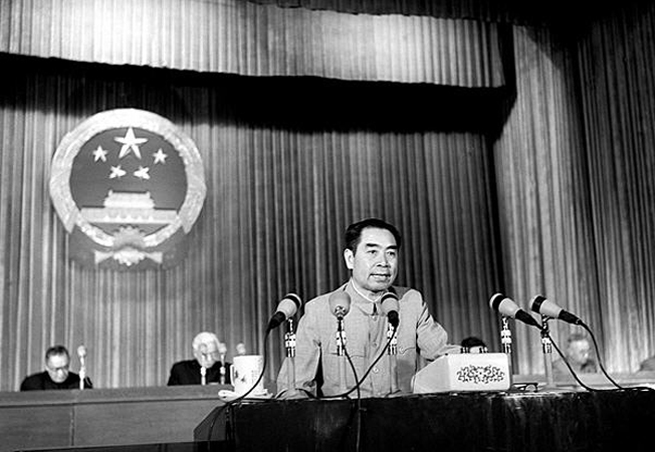 27China's former Premier Zhou Enlai delivers the "Government Work Report" during the 1st National People's Congress on September 15, 1954, in Beijing.
27China's former Premier Zhou Enlai delivers the "Government Work Report" during the 1st National People's Congress on September 15, 1954, in Beijing.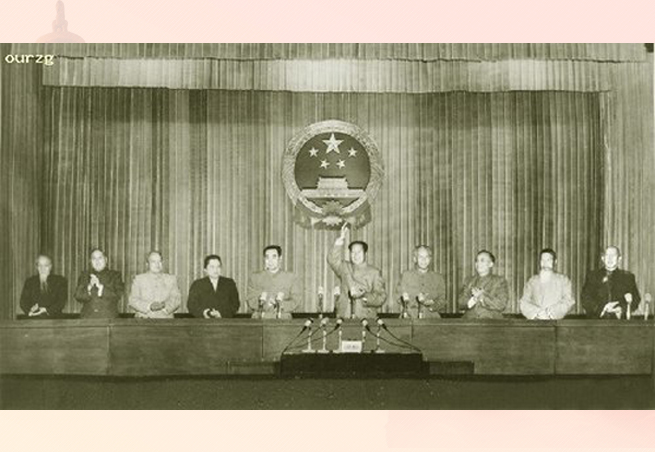 28The "Constitution of the People's Republic of China" was passed during the 1st National People's Congress in 1954.
28The "Constitution of the People's Republic of China" was passed during the 1st National People's Congress in 1954.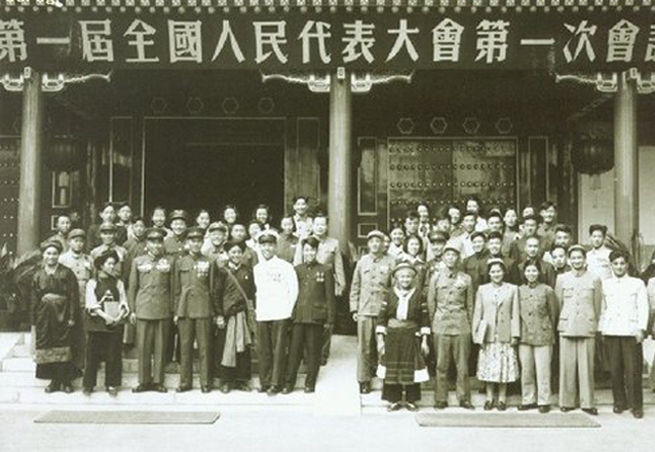 29A group photo of some deputies to the first session of the 1st National People's Congress. The meeting opened in Huairen Hall, Zhongnanhai, in Beijing at 3 pm on September 15, 1954.
29A group photo of some deputies to the first session of the 1st National People's Congress. The meeting opened in Huairen Hall, Zhongnanhai, in Beijing at 3 pm on September 15, 1954. 30China's former Premier Zhou Enlai waves to the crowd at Geneva International Airport on April 24, 1954. Zhou heading the Chinese delegation attended the Geneva Conference from April to July of 1954.
30China's former Premier Zhou Enlai waves to the crowd at Geneva International Airport on April 24, 1954. Zhou heading the Chinese delegation attended the Geneva Conference from April to July of 1954. 31China's former Premier Zhou Enlai meets with British Foreign Secretary Robert Anthony Eden during the Geneva Conference in 1954.
31China's former Premier Zhou Enlai meets with British Foreign Secretary Robert Anthony Eden during the Geneva Conference in 1954.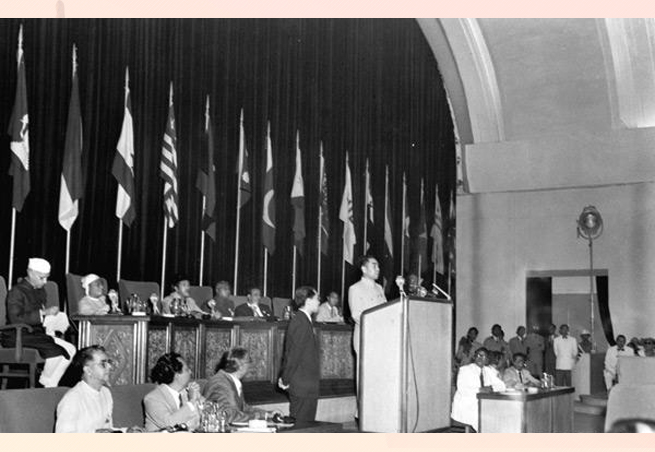 32Led by former Premier and former Minister of Foreign Affairs Zhou Enlai, the Chinese delegation arrived in Bandung, Indonesia, to attend the Bandung Conference on April 17, 1955. 29 counties attended the Bandung Conference, which lasted seven days, from April 18 to 24, 1955.
32Led by former Premier and former Minister of Foreign Affairs Zhou Enlai, the Chinese delegation arrived in Bandung, Indonesia, to attend the Bandung Conference on April 17, 1955. 29 counties attended the Bandung Conference, which lasted seven days, from April 18 to 24, 1955.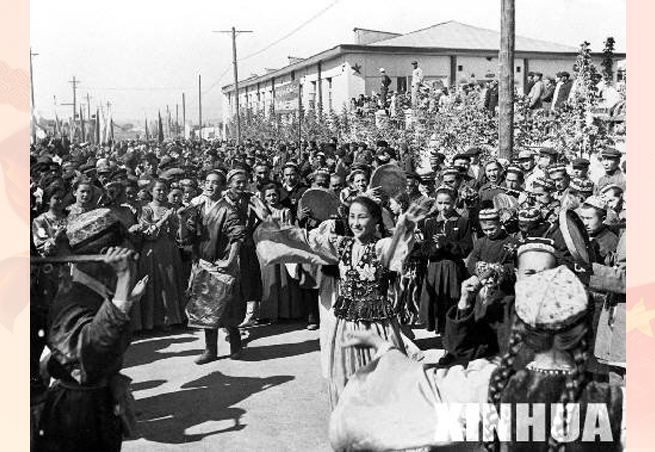 33September 30, 1955: Xinjiang Uygur Autonomous Region was officially established. In this photo, Xinjiang people are holding a celebration ceremony. The second session of the 1st Xinjiang People's Congress opened in Urumqi on September 20, 1955.
33September 30, 1955: Xinjiang Uygur Autonomous Region was officially established. In this photo, Xinjiang people are holding a celebration ceremony. The second session of the 1st Xinjiang People's Congress opened in Urumqi on September 20, 1955.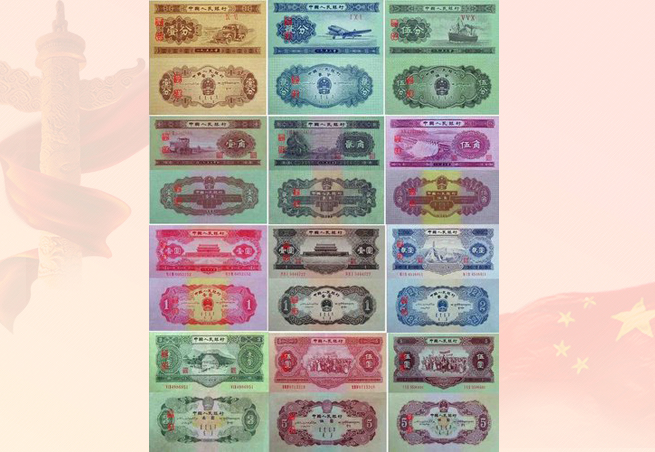 34This photo shows the second set of RMB bills issued on March 1, 1955.
34This photo shows the second set of RMB bills issued on March 1, 1955. 35This photo shows a Shanghai capitalist opening a store under public-private partnership in 1956. From 1953 to 1956, China carried out socialist transformation of its agriculture, handicrafts and capitalist industry and commerce.
35This photo shows a Shanghai capitalist opening a store under public-private partnership in 1956. From 1953 to 1956, China carried out socialist transformation of its agriculture, handicrafts and capitalist industry and commerce.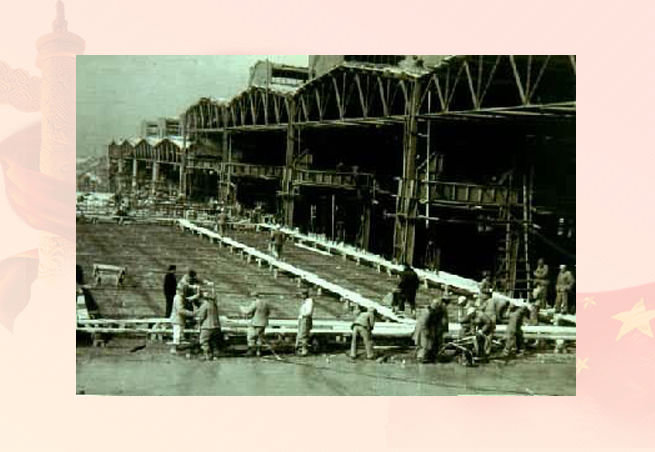 36First Automobile Works (FAW) was completed and put into production on July 15, 1956. FAW, located in Changchun City in northeast China's Jilin Province, is China's first automobile manufacturer.
36First Automobile Works (FAW) was completed and put into production on July 15, 1956. FAW, located in Changchun City in northeast China's Jilin Province, is China's first automobile manufacturer.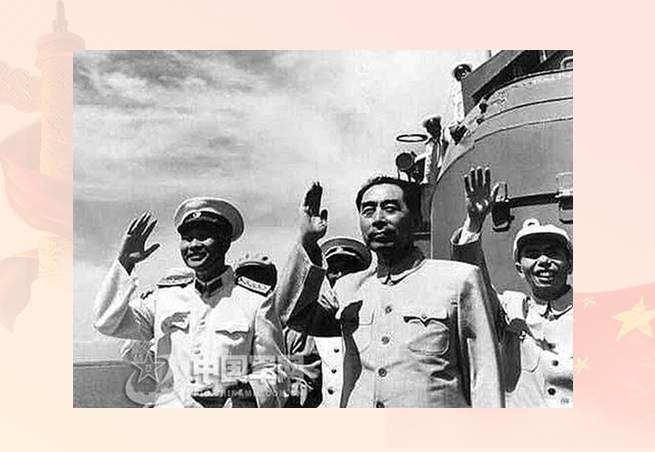 37Former Premier Zhou Enlai participates in China's 1st navy parade on August 4, 1957. The parade to celebrate the 30th anniversary of the Chinese People's Liberation Army was held on the Yellow Sea near Qingdao City in eastern China's Shandong Province.
37Former Premier Zhou Enlai participates in China's 1st navy parade on August 4, 1957. The parade to celebrate the 30th anniversary of the Chinese People's Liberation Army was held on the Yellow Sea near Qingdao City in eastern China's Shandong Province.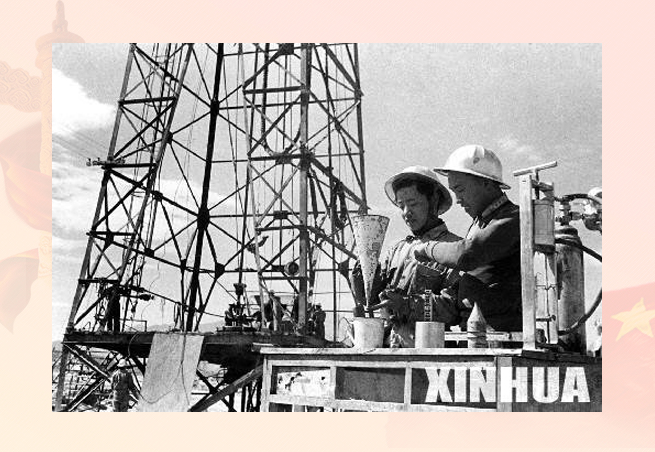 38China's first petroleum base, built in Yumen, was constructed on August 8, 1957. Crude oil production from the Yumen base, located in northwest China's Gansu Province, reached 755,500 tons in 1957.
38China's first petroleum base, built in Yumen, was constructed on August 8, 1957. Crude oil production from the Yumen base, located in northwest China's Gansu Province, reached 755,500 tons in 1957.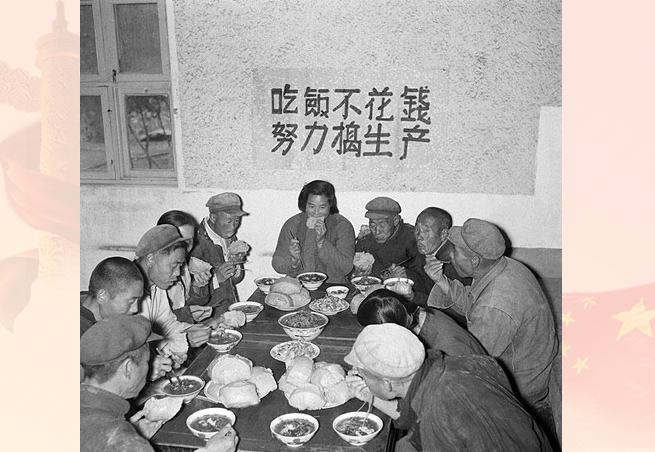 39This photo, taken on November 6, 1958, shows members of the Qinglongqiao workstation of the Haidian People's Commune having breakfast in the dining hall.
39This photo, taken on November 6, 1958, shows members of the Qinglongqiao workstation of the Haidian People's Commune having breakfast in the dining hall. 40China's first national television station, Beijing TV Station, formally started to broadcast programs on September 2, 1958, but it only covered the Beijing area at first. After May 1, 1978, however, Beijing TV Station was renamed as China Central Television (CCTV), and its establishment marked the beginning of China's television industry.
40China's first national television station, Beijing TV Station, formally started to broadcast programs on September 2, 1958, but it only covered the Beijing area at first. After May 1, 1978, however, Beijing TV Station was renamed as China Central Television (CCTV), and its establishment marked the beginning of China's television industry.
Comments